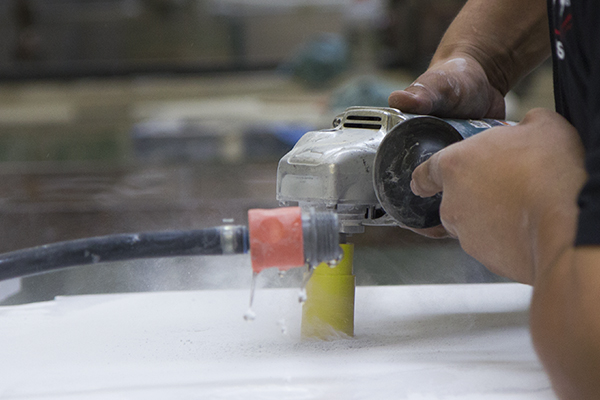4 Tips to Get The Most Out of Coring
If you're a fabricator experiencing trouble with coring, this article will provide you with practical suggestions you can immediately incorporate in your shop. Not only can you expect the life of your core drills to increase, but also the overall quality of your work to improve. Here are 4 tips to help you get the most out of your tooling and the coring process.
1. Knowing Your Bits
From our BigFoot series, TDCD series, to Xtreme series, each bit has its "best for" applications.

Terminator BigFoot Core Drills
Since it's introduction years ago, this has been a fabricator favorite on even the hardest of stones.
Learn More >

Terminator Drop Segment Core Drills
An excellent all-around bit for Granite & Engineered Stone. It shows slightly increased life when compared to the BigFoot series due to the thick 3mm segment. This bit likes to be broken in more than our other core drills.
Learn More >

Terminator Xtreme Core Drills
This is our fastest and arguably longest lasting bit in the Terminator lineup for dry coring. We've seen this bit consistently achieve less than 30 seconds a hole when broken in properly. It is also a great bit on Engineered Stone and Granite, (however for excessively hard materials, our first pick is still Bigfoot).
Learn More >

Terminator XT Thin Wall Core Drills | NEW 2017
Our newest premium Terminator® XT Thin Wall Core Drills have arrived. Without a doubt, these are the most precise, longest lasting thin wall core drills we have developed yet.
Learn More > CNC Version Available Here >

Terminator Continuous Thin Wall Core Drills
Thin wall construction and high diamond concentration makes this a great choice for coring marble, granite, ceramic, porcelain & single fired tile. This particular bit has been a fabricator favorite for years, with numerous shops choosing it as their preferred core drill, especially on easy to chip materials.
Learn More > CNC Version Available Here >

Thin Wall Core Drills
Thin Wall Core Drills are a popular option among fabricators, especially in situations that require an extremely clean hole with minimal chipping. The high concentration of fine diamonds, wall thinness, as well as continuous rim design makes these bits ideal for precise jobs.
When comparing the thickness of thin wall core drills to our more traditional segmented bits, the difference is substantial. Included below are measurements looking at wall thickness to illustrate this:
Terminator® Thin Walls
Terminator XT Thin Wall Core Drills: 1.67mm
Terminator Continuous Thin Wall Core Drills: 1.67mm
Terminator® Segmented:
Terminator Drop Segment Core Drills: 3.03mm
Terminator Xtreme Core Drills: 3.17mm
Designed to be used with water and across granite, marble, and engineered stone materials, Terminator® carries bits for both manual and CNC applications.
2. Selecting the Right Pads for the Job
Believe it or not, 80% of all failures stems from improper tool break-ins. As it pertains to core drills, “breaking-in” means letting the new sharp-edged corners become rounded over, allowing for optimum diamond exposure.


The most common dry coring procedure on site or in the shop is to, start at a slight angle and slowly drop the core bit into the stone, in a counter clockwise or clockwise motion until the surface of the stone is penetrated. Then, gradually accelerate this initial motion of wallowing out the core until the hole is cored out. Since the core drill is only cutting on the tipped edges, it is critical to break them in properly.
To do so, always start at a lower RPM than recommended during normal operations when first using any series of Terminator’s Dry Core Drills. Typically for all 1-1/4” to 1-1/2” core bits we recommend 3800 RPM on your grinder. Taking the time to do 5 to 6 holes in this patient manner will yield dividends relating to the longevity and speed of the bit throughout its useful life. Once broken-in, follow the recommended RPMs.
3. Adjust RPM when Necessary
When coring exotic materials, there is no one size fits all recipe, for how fast or what particular RPM to run. Our listed RPM ranges apply for those stones in “class three hardness” granite scale. Anything harder and you will need to reduce the RPMs on your grinder to accommodate. We suggest starting your adjustments in increments of 500 RPM. (We commonly see core drills fail due to RPMs being set too high)
Recommended RPMs
BigFoot / Drop Segment Core Drills - 5,000 to 6,000 RPM
Xtreme Core Drills - 6,500 - 11,000 RPM
4. Let the Core Bits Breathe
Everybody wants to core those holes and get it done as fast as possible. However, not allowing the core bit to catch a breather tends to yield counter productive speeds and the chances of burning. Our most versatile coring bit, the BigFoot, comes with a turbo segment design to assist in this cooling right out of the gate. When possible, always use a helper and a good wet/dry vacuum to assist in dust removal and any heat the core bit creates on site.

Another helpful technique seen in the field is to use a Terminator Suction Ring, filled with crushed ice to aid in the cooling process. As an added benefit, this also eliminates dust as the ice melts into water during coring.
Learn More >
Note: We suggest using this technique with a catch bucket underneath your customers cabinets if doing this in the field.
Please use these methods at your own discretion, and put the main focus on letting the core bit breathe - this means coring a little and lifting the bit up just a few millimeters while spinning in order for air to cool the bit down.
While all dry core drill are designed to be used in dry applications, these recommendations will only further maximize the life of your core bits.
Thank you for reading and we hope you’ve enjoyed this article!
Team TERMINATOR® D.I.A. Diamond Products
